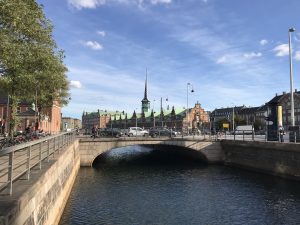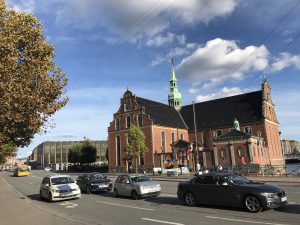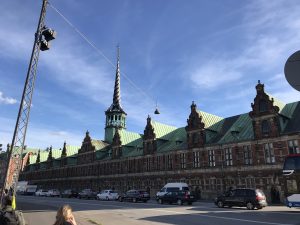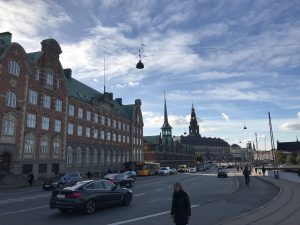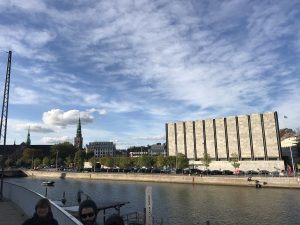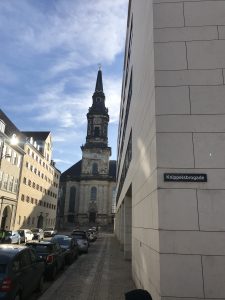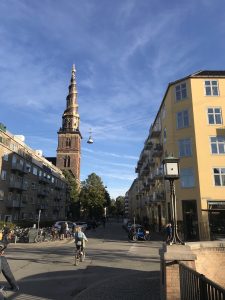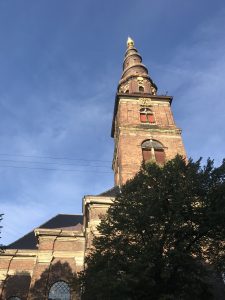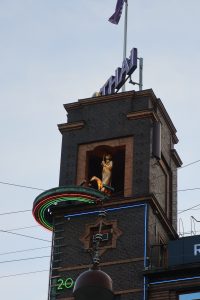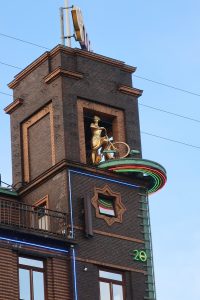September 27, 2018 – The Royal Tour of Copenhagen, Or Maybe Christiania Tour, From Two Days Ago
I just got off the bus in Odense, a place I’d describe as a city suburb. The FlixBus let us off in a commuter parking lot and I wandered past various fast food chains and an Ikea before settling on a mall. I can’t check in for a few hours to my AirBNB so I figured I’d avail myself of free WiFi and a food court. This place is under construction and while there’s WiFi, the food options are bafflingly spread out and I haven’t seen anything in my walkabout that struck my fancy. So I’m slurping down a Coke Zero and sitting, reconstructing my notes on the Royal Tour of Copenhagen… which may actually be called The Christianshavn Tour.
Luis was out guide, an ex-pat from Peru who’s been in Denmark for close to five years. While he was informative and funny, he’s less of a tour guide and more of a… game show host? Entertaining to be sure. But also… I was never sure if he was laughing with us or at us.
In any case, the majority of this tour included works, efforts, and provisions undertaken by that most famous of Danish King, Christian IV (who reigned from 1588 – 1648). We’ve heard a lot about him in the last few tours and there’s more to come here. Though known as “The Builder” he wasn’t above wreaking havoc either – he bankrupted the country a few times warring with the Swedish. Lousy, stinkin’ Swedish.
We walked toward the funky neighborhood of Christianshavn, home to the Christiania “green light district” of open-air marijuana and a purported “independent” nation within Denmark. We’ll get to more on that before we’re through, albeit without any photos because they don’t allow it.
In any case, our first stop along the way was past a statue for Frederick VII who reigned from 1848 to 1863. He didn’t do a lot as a king, trying very hard to emulate Christian IV and not really succeeding. His greatest claim to fame is that he lost the monarchy. It was under his tenure that the people rose up and were able to get democracy and while apparently he originally was on the fence, when the masses started marching on his palace, he quickly became very pro-democracy. As a result, he gets his statue outside Parliament.
***
The Church of the Holy (Holmes Kirken in Danish… and we already learned Kirken is church, so Holmes, well, smell ya later). The greatest named warrior in Danish history is buried here – Luis would tell us his tale later – but his name is Peter Tordenskjold, or literally “Peter Thundershield.” Oh, and Queen Margaret was married here. But who cares when there’s a guy named PETER THUNDERSHIELD to look forward to hearing about.
So here’s the deal with PT – he came from Norway in 1690… but don’t hold that against him. He was a bit of a firebug and hellraiser and his parents thought Denmark would do him some good. His daredevil personality made him an ideal warrior in that he was always the first to volunteer for any assignment that was a suicide mission… the more “they were expendable” the better for Peter Thundershield. But he kept winning the day and coming back alive. He rose through the ranks faster than anybody in Danish history. When he was 26, he was dispatched as a spy. There was an armada massing on the Danish seas readying to attack. The king knew a frontal assault would only leave to failure, so he dispatched Peter on an impossible mission – as a solo agent, he could infiltrate and take out the whole fleet. Peter’s plan? He always loved fire… so he single-handedly burned the entire enemy fleet (single handedly, I ask? There are only two people I can think who might have done such a thing single handedly – Douglas Fairbanks in “The Black Pirate” and Gil Gerard as Buck Rogers in the eponymous pilot movie). Anyway, Peter THUNDERSHIELD is made a noble lord at 26, the youngest naval officer ever.
Sadly, he was a victim on his own success in that now he was famous and so his spying days were done. Peace had broken out so there wasn’t a lot of fighting to be done. And as a lord he wasn’t allowed to duel… although there was a minor loophole in that for honor’s sake he couldn’t allow an insult to stand. So Peter became very, very annoying. He’d play cards and get bored and randomly accuse someone of cheating just so they’d challenge him to a duel. And he was so reknowned as THUNDERSHIELD that often times the accuser wouldn’t even show up to the duel., confident they’d lose anyway, so Peter would win by forfeit and gain ever more glory (how this satisfies his bloodlust/deathwish, I’m not entirely clear on but who can know the workings of a Thundershield’s heart?). He got cocky and didn’t even bother brining weapons to the duel assuming he didn’t need them… until one day he did. In 1720, at the ripe old age of 30, Peter annoyed the wrong guy. A Colonel who shows up at the appointed hour has his sword and Peter has… he pats his clothes… a ceremonial dagger. Rather than forfeit, Peter says he’ll fight the guy with his dagger – only to be run through almost immediately by the Colonel’s blade. Peter Thundershield dies a fool, hosited by his out petard… or should I say PETER-tard!
The story doesn’t end there though. Because the punishment for a noble killed in duel was to be thrown into a pauper’s grave, the government covered all this up. They told everyone he was off on a spy mission. It was only 50 years later that the crown revealed he had been buried privately by friends and family in a small service at the Church of the Holy. So one last time Peter Thundershield cheats life in death.
THUNDERSHIELD, HO!
Oh, and Luis claims because of his penchant for burning and his success taking out that enemy armada singlehandedly, PT’s image is on a lot of Danish matchbooks and thus is still setting things on fire! I will say Luis said I could walk into any souvenir shop and find one of these matchbooks. I walked into 7. None of them had them.
***
In 1610, Christian IV built the Copenhagen stock exchange. He wanted the spire at the top to be visible to everyone in Copenhagen (which it was at that time, and still is to everyone in Old Copenhagen). He told the architect his vision was one of three crocodiles in a death spiral roll. Why he wanted that I never found out from Luis, but the point is the architect had never seen a crocodile so gave it his best shot. The people thought it looked like a dragon, a sort of adopted mascot for the town that burns so frequently. I think it looks like a unicorn or narwhal.
***
In the 1950s there was a bohemian arts boom in this part of town but with success comes money and with money there comes a stylistic conflict and eventually so goes affordable housing and the stuff that made the place more unique can get rounded off and homogenized. As it stands therefore, there’s a mishmash of cool and funky style with monolithic incongruous buildings… but that’s something I’ve seen a lot of in cities all over the world. It’s hard to preserve the past, though necessary when we can. But it’s also VERY expensive to preserve the past – the stock exchange building in fact is available for “lease” but you can only restore it, not change anything on the outside or inside – remember, this place was built in 1610. It could use maybe a few modern touches. But it’s been on the market for a long time as no one wants to deal with the planning permission hassles.
***
The Black Diamond, where I would spend some time the other day tapping out a blog post or two, was built to secure the Danish Library. In the older building, there was a copy of every book ever written and published in Danish… that is until 1978-1986 the director smuggled out and stole close to 1600 first editions. He sold 100 of them before people realized… and while authorities were able to recover the unsold lots, those 100 books are still missing.
It was decided therefore to build something more secure as well. Hence the Black Diamond. It sits on the waterfront and somebody decided the basement was the best place to store the priceless archives… except the basement was under water and was built out of granite, one of the more porous rocks they could’ve chosen and the library sprung a leak. They’ve now spent a small fortune re-sealing the basement to preserve and protect their literary heritage. Luis asked why they didn’t just move the collection to the top floor.
***
Quick note on this Church we wandered by. It’s the first Danish church to hold services in a different language. It was built in the 1750s by Frederick V because German residents wanted a local option for their church. The king agreed but on one strict condition – the church would only be for Lutheran services. The puzzled Germans readily agreed because, well, they WERE Lutheran and this is kinda what they wanted anyway…
***
The Church of Our Savior was built in 1619 with a unique counter-clockwise spiral tower. The legend says the architect did it so when swordfighting and defending the place, the Danish could duel while holding the railing and thus gain an advantage. But once completed he realized there wasn’t room to swing the sword then from those angles and in disgrace the architect threw himself from the top of the spire and died.
Total BS. Most cities have a story about a wacky architectural element and how once it happened the architect throws himself off the structure in disgrace. Budapest has one about lions on a bridge that I heard last year. But to this day, Luis says, EVERY Copenhagen will tell you the “true” story about how this architect killed himself on that spire. It’s the most popular urban legend… and the most oft believed.
The reality is the architect died of old age, quite content that his counterclockwise spiral was done that way because that’s how you’re supposed to climb the stairway to heaven.
***
So the tour ended at the gates of Christiania. This enclave came into being in 1971 when a group of hippies found an abandoned WWII military base that still had all kinds of buildings and services – including running water and electricity. So they moved in as a social experiment. And the government signed off on it mainly because they were 100% positive the thing would collapse spectacularly and they could prove once and for all that the hippie revolution was a roadmap to failure. They were dead wrong as the next day the place was going to celebrate its 47th anniversary. There’s even signs up at the entrance reminiscent of Checkpoint Charlie – “You are now entering Christiania” on the way in, and “You are now entering the EU” on the way out.
The Green Light District inside has stalls and kiosks and full blown restaurants offering marijuana and hemp in a variety of products and strains. There are three rules for Christiania, Fight Club style.
- Rule 1: No Photos.
- Rule 2: Don’t run… because if you run, everyone thinks it’s a raid and all hell breaks loose.
- Rule 3: Have fun!
A note on the raids – when I walked in to take a look around, there was indeed a police raid, a squad of cops in full on riot gear, hustling out two guys in handcuffs as locals shouted and jeered and take cell phone video (but, but… rule # 1 is no photos?!). It is still illegal to sell marijuana in Denmark… but when they cracked down on Chrisitiana in the past it only lead to the trade diffusing throughout Copenhagen. So the authorities tend to turn a blind eye to the area, preferring to keep all trade in one location. I heard this and could only think of “Hampsterdam” from The Wire season 3 or 4, a solution to centralize the drug trade in one particular area of Baltimore.
I didn’t stay long, though I did stroll through the place. It smelled like college. I’ve never smoked anything in my life save for second hand. I did my best not to inhale here albeit I really could have gone for some Pokey breadsticks or Cinnamon Toast Crunch.
***
One final note before I close the book on Copenhagen and head out into Odense. Near City Hall # 5 is a tower with a digital thermometer and an alcove at the top. The alcove serves as visual weather forecast such that if there’s a chance of rain, a golden woman carrying an umbrella is at the forefront; if it’s a sunny day, there’s a woman riding a bicycle. Unfortunately, for many years now they’ve left them both kind of in and out of the alcove, which I guess means there’s always a 50/50 chance of rain… or sun. And honestly, I’ve long thought that was the best forecast a weather prognosticator could give — you’re never wrong if you say there’s always a chance.
I wonder what’s the forecast for Sunday in Odense for the marathon?

